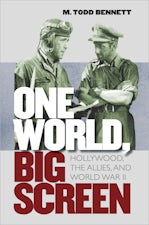Transpacific Convergences
Race, Migration, and Japanese American Film Culture before World War II
By Denise Khor
208 pp., 6.125 x 9.25, 35 halftones, 2 maps, appends., notes, bibl., index
-
Paperback ISBN: 978-1-4696-6797-3
Published: July 2022 -
E-book PDF ISBN: 979-8-8908-5471-1
Published: April 2022 -
E-book EPUB ISBN: 978-1-4696-6798-0
Published: April 2022 -
Hardcover ISBN: 978-1-4696-6796-6
Published: July 2022
Studies in United States Culture
Buy this Book
- Paperback $27.95
- Hardcover $95.00
- E-Book $21.99
For Professors:
Free E-Exam Copies
Awards & distinctions
A 2023 Choice Outstanding Academic Title
Khor opens up transnational lines of inquiry and draws comparisons between early Japanese American cinema and Black cinema to craft a broad and expansive history of a transnational public sphere shaped by the circulation and exchange of people, culture, and ideas across the Pacific.
About the Author
Denise Khor is assistant professor of American studies at the University of Massachusetts, Boston.
For more information about Denise Khor, visit
the
Author
Page.
Reviews
"Illuminating . . . Khor clarifies how the Japanese American film culture has been shaped by the transpacific circulation of people, things, and ideas. She also demonstrates how its narratives and histories have been mediated in or haunted by these geopolitical concepts and theories."—Japanese Studies
"Transpacific Convergences reveals diverse worlds of Japanese American leisure, recreation, and community building almost entirely new to the historiography . . . These worlds unfold against transformations in the Hollywood and Japanese film industries, while Khor also highlights parallels with Black race films to frame out her story."—Western Historical Quarterly
“A marvelous, well-researched exploration of Japanese American film culture. . . . This methodical, exemplary book is a valuable contribution to early-20th-century film culture in the US. Essential.”—CHOICE
"Transpacific Convergences offers a rich portrait of Japanese American film culture, and deftly shows how it emerged and thrived by engaging the wider Pacific world. The story is told with admirable efficiency and clarity. Students and scholars of history, film, and culture will learn a great deal from it."—Diplomatic History
“Rich in historical insight and historiographic intervention . . . [Khor] connects the histories of cinema and Asian American immigration in novel and valuable ways while also illuminating the fascinating lives of its characters, the rich social worlds they inhabited, and the remarkable cultural texts they created.”—Southern California Quarterly
"A significant contribution toward alternative film histories and might usefully help both scholars and students alike not only decenter the West but also imagine new historical trajectories for the moving picture that place minoritized groups at the center rather than the margins of the story. . . . Khor’s work is a welcome addition to scholarly inquiries into the circulation of films and film culture in racialized communities in the United States in the first half of the twentieth century."—Journal of Cinema and Media Studies



